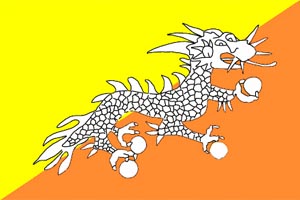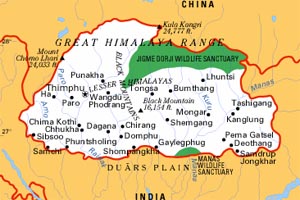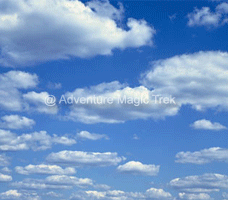
24 Hours Support Call
+977-9841570317 (Shankar Pandey)
email:info@adventurehikenepal.com
Facts of Bhutan
Overview of Bhutan
 Clinging to a black rock face, 800 meters above the valley floor, nestles Taktsang Lhakhang, one of the holiest sites of Himalayan Buddhism. Such is the sense of peace and serenity as the quiet approach path winds through lush meadow, oak and rhododendron forest, past quaint hamlets, fluttering prayer flags and rotating prayer wheels, and along the precipitous cliff, it is difficult to believe that Bhutan's only airport is barely kilometers away. Taktsang, the tiger's lair, acquires its name from the legend of its foundation, when in the 8th Century Guru Rinpoche, widely revered as the second Buddha, arrived from Tibet flying across the mountains on the back of a tigress. He meditated at the site for three months, from where he used the religious cycle of the Kagye to subjugate the Eight Categories of Evil Spirits, and thus converted the region to Buddhism. Over the centuries many luminaries came to meditate at this intensely spiritual place, enriching the legacy of its founding master and strengthening belief in the Buddhist faith.
Clinging to a black rock face, 800 meters above the valley floor, nestles Taktsang Lhakhang, one of the holiest sites of Himalayan Buddhism. Such is the sense of peace and serenity as the quiet approach path winds through lush meadow, oak and rhododendron forest, past quaint hamlets, fluttering prayer flags and rotating prayer wheels, and along the precipitous cliff, it is difficult to believe that Bhutan's only airport is barely kilometers away. Taktsang, the tiger's lair, acquires its name from the legend of its foundation, when in the 8th Century Guru Rinpoche, widely revered as the second Buddha, arrived from Tibet flying across the mountains on the back of a tigress. He meditated at the site for three months, from where he used the religious cycle of the Kagye to subjugate the Eight Categories of Evil Spirits, and thus converted the region to Buddhism. Over the centuries many luminaries came to meditate at this intensely spiritual place, enriching the legacy of its founding master and strengthening belief in the Buddhist faith.
Through its setting and history, Taktsang stands as a evocative metaphor for Bhutan itself, alluding to some of the defining elements of the diminutive Himalayan kingdom: a spiritual sanctuary, enriched by the thoughts and actions of its ancestors and an enduring intensity of faith; an ecological enclave, where geographical circumstance and human humility have united to preserve an abundant, multi-layered, undistracted environment; a secluded land, occupying a precarious niche in a fast encroaching modern world. Drukyul, the Land of the Thunder Dragon, is particularly distinctive in that it has preserved its overall identity to remain a traditional microcosm somewhat removed from wider global realities. The nation has thus far been blessed with the ability to reproduce itself through ever changing circumstances. In 1998 the Taktsang complex was heavily damaged by fire. The following year popular excitement greeted the discovery of a young boy as the reincarnation of Tenzing Rabgye, the fourth temporal ruler of Bhutan, responsible for originally building the destroyed buildings in 1692. The successful reconstruction is now nearing completion.
Bhutan Festivals
 Religious festivals are perfect occasions to glimpse what might be termed Bhutanese culture. Celebrated throughout the country, they occur in a host of differing forms, depending upon the scale, the nature of the ceremonies performed or the particular deity being revered. The best known are the Tshechus, festivals which honor Guru Rinpoche and celebrate one of his remarkable actions, and the most popular of these take place annually in or around the great dzongs, attracting both tourists and large numbers from the surrounding districts. Lasting several days, the central focuses are the series of prayers and religion inspired dances. These dances, made especially striking by the spectacular costumes of the dancers - bright silks and rich brocade, ornate hats or extraordinary masks - may either depict morality tales, invoke protection from demonic spirits or proclaim Buddhist victories and the glory of remarkable saints.
Religious festivals are perfect occasions to glimpse what might be termed Bhutanese culture. Celebrated throughout the country, they occur in a host of differing forms, depending upon the scale, the nature of the ceremonies performed or the particular deity being revered. The best known are the Tshechus, festivals which honor Guru Rinpoche and celebrate one of his remarkable actions, and the most popular of these take place annually in or around the great dzongs, attracting both tourists and large numbers from the surrounding districts. Lasting several days, the central focuses are the series of prayers and religion inspired dances. These dances, made especially striking by the spectacular costumes of the dancers - bright silks and rich brocade, ornate hats or extraordinary masks - may either depict morality tales, invoke protection from demonic spirits or proclaim Buddhist victories and the glory of remarkable saints.
And then there are the atsaras - clowns sporting fiendish masks, making lewd gestures and cracking salacious jokes - who mingle on the periphery of the performance, are entitled to mock both spiritual and temporal subjects, and through their distractions infuse a lighter side to otherwise serious matters. The whole gathering begins to resemble a country fair, as the jolly and convivial assembly - many turning out in their vibrant finery - further entertains itself in lively conversation, the playing of an assortment of games and the imbibing of copious amounts of food and alcohol. Tshechus may end with the bestowing of powerful blessings, delivered orally by a high lama or visually with the unfurling of a huge appliqué thangka representing Guru Rinpoche and his Eight Manifestations. The commanding backdrop of a monastic fortress, the visual extravagance of the dances, the cacophony of musical accompaniments, the solemnity of chanting mantras, the artistic splendor, the unfamiliar smells and the overall exuberance of the diverse crowd lend the scene an extremely exotic air.
Culture & Religion of Bhutan
Bhutan's national flag is a white dragon on a diagonally divided background of golden yellow and reddish orange. The yellow represents the secular power of the King, the orange the Buddhist religion. The white of the dragon is associated with purity, and the jewels held in the claws stand for the wealth and perfection of the country. The national emblem is composed of a double diamond thunderbolt placed above a lotus, surmounted by a jewel and framed by two dragons, all contained within a circle. The thunderbolt represents the harmony between secular and religious power resulting from the Vajrayana form of Tibetan Buddhism, the lotus symbolizes purity, the jewel expresses sovereign power and the two dragons, male and female, stand for the name of the country, Drukyul, the land of the thunder dragon.
Bhutan is the only country to maintain Mahayana Buddhism in its Tantric Vajrayana form as the official religion. The main practicing schools are the state sponsored Drukpa Kagyupa and the Nyingmapa. Buddhism transects all strata of society, underpinning multiple aspects of the culture. Indeed, religion is the focal point for the arts, festivals and a considerably above average number of individuals. The presence of so many monasteries, temples and stupas, monks and tulkus (reincarnations of high lamas) is indicative of the overarching role religion plays throughout the nation.
Although the Shabdrung is regarded as the founder of the nation, the secular realm has achieved an unprecedented degree of unity under the influential guidance of a Twentieth Century monarchy. Within a cultural context where the spiritual and temporal spheres are intimately connected, political leadership remains interpreted as divinely determined. The royal family traces its roots to the great Sixteenth Century saint Pema Lingpa, and the present monarch still enjoys a god-like status throughout much of his Kingdom. The Forth King Jigme Singye Wangchuck as the head of state now rules the Kingdom, with the throne retaining its position as the fulcrum of the political system.
Bhutanese art possesses a major Tibetan influence, although it has developed some of its own derivations. It has three main characteristics: it is anonymous, religious and performs no independent aesthetic function. Intricate wall paintings and thangkas (wall hangings), most historical writing and fine sculpted images all have a religious theme. Given their role, these may be interpreted as created by artisans rather than artists, although there exist many extremely fine examples. All are viewed as sacred, and newly commissioned paintings and sculptures are consecrated through a special ceremony whereby they come to personify the respective deities.
Although both Buddhism and the monarchy are critical elements, it is the general extensive perpetuation of tradition that is possibly the most striking aspect of Bhutan's culture. This is most overtly reflected in the nature of dress and architecture. All Bhutanese continue to wear the traditional dress: for men and boys the gho, a long gown hitched up to the knee so that its lower half resembles a skirt, for women and girls the kira, an ankle-length robe somewhat resembling a kimono. Generally colorful apparel, the fabrics used range from simple cotton checks and stripes to the most intricate designs in woven silk.
The Bhutanese architectural landscape is made up of chortens, stonewalls, temples, monasteries, fortresses, mansions and houses. Associated with a number of clear-cut architectural concepts and building types rooted in Tibetan Buddhism, there is a strong association between state, religious and secular forms. What makes it quite unique is the degree of uniformity, with all structures corresponding to traditional designs. Thus ancient monasteries and fortresses appear to merge with more modern popular dwellings to create a setting that is fully internally consistent.
History of Bhutan
To review Bhutan's history is to appreciate the continuing importance of the country's heritage and the ongoing interplay between the past and the present. The contemporary situation essentially remains the accumulated product of a long and isolated past. Significantly, until the modern era there had occurred no major watersheds, dislocating the country from its previous traditions and placing it on an alternative trajectory. This design tends to both reinforce a continuing intimacy and bestow an unusual degree of continuity. A steady and consistent process of internal succession is punctuated by four defining moments: the arrival of Buddhism closely followed by the profound presence of Guru Rinpoche; the birth of the nation upon unification by Shabdrung Ngawang Namgyal; the establishment of a monarchy under the First King Ugyen Wangchuck; and collective integration within regional and global systems and the beginning of modernization.
Circumstantial evidence suggests that the land was inhabited by around 2000BC. Not much is known about these pre-historic peoples and their cultures or their relationship with the surrounding regions. The country's demographic history is however one of ongoing migration, reflected in the chronology of the three broad ethnic groupings: first the Sharchops of Indo-Mongoloid origin; then the Ngalops of Tibetan origin; and more recently the Lhotsams of Nepali origin. Prevailing community structures - dispersed, localized, agrarian and self-sufficient - indicate a relative stability in underlying social and economic conditions. Upon this essentially constant background is placed an overwhelming and deeply interrelated religious and political overlay.
Prior to the arrival of Buddhism in the Seventh Century, communities subscribed to the Bon religion, characterized by the worship of spirits associated with elements from the natural environment. The Buddhist religion merged these beliefs within its broader framework, and through its diffusion became the first collective authority and cohesive force. Many influential religious figures either traveled through or made Bhutan their home. The nation first achieved a degree of political unity in the Seventeenth Century under the extraordinary leadership of Shabdrung Ngawang Namgyal, the hierarch of the Drukpa Kagyupa religious order. He established a centralized theocracy of intertwined religious and secular rule, simultaneous and somewhat akin to the Tibetan Gelugpa system under successive Dalai Lamas.
Until the seventeenth century the country consisted of a dislocated collection of local fiefdoms ruled by families of noble descent. The political hierarchy implied by nobility highlights the intimate relationship between spiritual and temporal legitimacy. This was further underlined by the Drukpa theocracy, which provided an initial sense of nationhood even though it did not achieve continuing secular stability. The process of internal political unification finally reached a logical conclusion in the early Twentieth Century with the introduction of a hereditary monarchy. Having spent most of its history isolated from significant external influence, Bhutan became more intimately linked with the modern world in the early 1960s. This signifies the most far-reaching political development in the nation's history, as it becomes connected to the subtle multidimensional powers implied by the modernization process.
Traveler’s Information:
IDEA
A trip to Bhutan has captured your imagination. Use our site and any other useful resources to get a general idea of when you want to come, where you want to go and what activities you want to do.
DIALOGUE
Contact us through the site to discuss your travel plans. A two-way dialogue will enable us to provide you with more detailed trip-related information, answer your queries and find a solution that matches your individual requirements.
DECISION
Decide on the package that is best for you and book your trip. We will provide you with contract, payment details and receipt.
PREPARATION
Make the necessary preparations for your trip. We will send you a checklist, be on hand to answers any questions and will proceed with all the necessary logistical arrangements, including visas, transport, hotels and guides.
ARRIVAL
Depart for Bhutan. We will contact you at your last destination before entering the country. Upon arrival, our representative will meet you at your port of entry and assist in any formalities.



